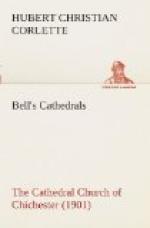[5] Walcott, p. 15.
[6] Author of “Architectural Parallels.”
Evidently, if the upper part of the tower did not fall, it is apparently certain that it was reconstructed, in order to carry the additional weight of the larger tower. But in examining the documentary evidence offered us, we find some further help. The teaching of archaeology shows that the portion of this tower above the main supporting arches and up to the bottom of the parapet was executed between 1225 and 1325—that is, it was finished not very long after the new part of the south-west tower was completed.
The cathedral statutes show that between the years 1244-1247 Bishop Ralph Neville was much concerned about a “stone tower” which he wished to see completed. They tell us, too, that the same bishop had himself expended one hundred and thirty marks upon the fabric, [7] and that his executors, besides releasing a debt of L60 due to him and spent on the bell-tower, gave L140 to the fabric of the church. Ralph died in 1244, so it is concluded that the work in which he was so interested was none other than the central or bell-tower of the cathedral, and that the earlier tower, with its supporting arches, must have fallen, else it is not likely that the work would have been rebuilt from below the spring of these arches before the new superstructure could be added; for we are obliged to take the customs of mediaeval builders into consideration in any attempt to sift the evidence concerning their work—and they were before all things practical. The claims of structure, the motives of common-sense, rather than abstract and aesthetic ideals of beauty, were the prime causes at work in the evolution of their great art. Here they found themselves faced by a practical need—the rebuilding of a fallen tower. Its reconstruction was necessary to the completeness and stability of the building; so they put it up, applying new and increasing knowledge and skill in the execution of the work. They did their best, and the result was something not only strong and structural, but beautiful. But, as time has shown, it would have been better had they been less respectful of the valueless legacy bequeathed to them in the piers, though in defence of their sagacity it must be admitted that what they deemed sufficient for the purpose then in view was able to carry their own tower for five hundred years in safety, and not only this, but, in addition, a spire, the erection of which they may not have thought of when the restoration was begun.
[7] Walcott, p. 15.
There is another interesting fact which may be mentioned before quitting this part of our inquiry. Professor Willis found that there still existed in 1861 one of the old wooden trusses of the roof over the west bay of the chancel. It was a specimen of mediaeval carpentry six hundred and fifty years old, and it had not, as he showed, been unframed since the fire of 1186-1187. The timbers composing it had been slightly charred by the flames, and some of the lead which covered the burning roof had run in its melted condition into the mortices of the framing. [8]




